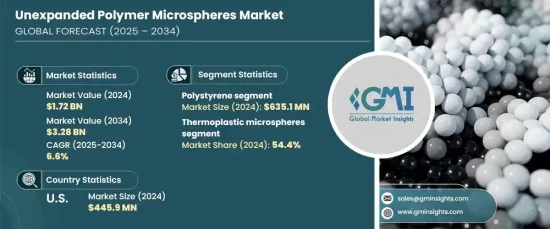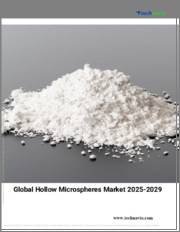
|
시장보고서
상품코드
1666621
세계의 미팽창 폴리머 마이크로스피어 시장 기회, 성장 촉진요인, 산업 동향 분석 및 예측(2025-2034년)Unexpanded Polymer Microspheres Market Opportunity, Growth Drivers, Industry Trend Analysis, and Forecast 2025 - 2034 |
||||||
미팽창 폴리머 마이크로스피어 세계 시장은 2024년에 17억 2,000만 달러에 달헀고, 2025-2034년 연평균 6.6% 성장할 것으로 예상됩니다.
경량성과 우수한 단열 포장 능력으로 유명한 이 마이크로스피어는 건축, 자동차, 포장에 이르기까지 다양한 분야에서 필수 불가결한 요소로 자리 잡고 있습니다. 재료의 무게를 줄이고, 유연성을 높이며, 효율적인 단열을 실현하는 능력은 현대 제조 산업에서 중요한 구성 요소로 자리매김하고 있습니다.

미팽창 폴리머 마이크로스피어의 채택이 증가하는 배경에는 지속가능성과 효율성으로의 전환이 있습니다. 또한, 고분자 기술의 발전은 보다 특수한 마이크로스피어의 개발을 촉진하고 그 응용 가능성을 확대하여 시장 성장을 가속하고 있습니다. 경량 복합재료와 에너지 효율적인 재료에 대한 관심이 높아지면서 미팽창 폴리머 마이크로스피어에 대한 세계 수요가 더욱 증가할 것으로 예상됩니다.
| 시장 범위 | |
|---|---|
| 시작 연도 | 2024년 |
| 예측 연도 | 2025-2034년 |
| 시작 금액 | 17억 2,000만 달러 |
| 예상 금액 | 32억 8,000만 달러 |
| CAGR | 6.6% |
2024년에는 폴리스티렌 부문이 6억 3,510만 달러 규모로 미팽창 폴리머 마이크로스피어 시장을 주도했습니다. 다재다능한 폴리스티렌 마이크로스피어는 복합재료, 페인트, 코팅 등의 용도로 사용되는 재료로 높은 평가를 받고 있습니다. 폴리스티렌 마이크로스피어는 재료의 구조적 무결성을 유지하면서 효과적으로 경량화할 수 있어 제품 성능을 향상시키고자 하는 제조업체에게 필수적인 선택이 되고 있습니다. 한편, 폴리프로필렌 마이크로스피어는 뛰어난 내열성과 다양한 소재와의 호환성으로 인해 꾸준히 인기를 얻고 있습니다. 뛰어난 열 안정성으로 인해 고온 성능이 가장 중요한 산업에서 필수적인 존재가 되어 시장에서의 채택을 더욱 촉진하고 있습니다.
열가소성 마이크로스피어는 2024년 시장 점유율 54.4%를 차지하며 지배적인 부문으로 부상했습니다. 이 마이크로스피어는 열에 의해 연화되어 형태를 바꿀 수 있는 적응성과 구조적 강화 특성으로 인해 큰 주목을 받고 있습니다. 자동차, 건축, 포장 분야에서 널리 사용되는 열가소성 마이크로스피어는 산업계가 성능을 최적화하기 위해 가볍고 다재다능한 소재를 선호하기 때문에 수요가 높습니다. 기술 혁신의 발전과 광범위한 채택으로 이 분야는 2034년까지 선도적인 위치를 유지할 것으로 예상됩니다.
북미는 2024년 4억 4,590만 달러 규모의 미팽창 폴리머 마이크로스피어의 주요 시장으로 자리매김했습니다. 이 지역의 자동차 및 코팅 산업, 엄격한 규제 기준, 지속가능성에 대한 강조가 성장의 주요 원동력이 되고 있습니다. 또한, 북미의 의료 분야는 시장 확대에 있어 중요한 역할을 하고 있습니다. 약물 전달 시스템에서 진단 용도에 이르기까지 고분자 마이크로스피어는 헬스케어 솔루션 개발에 필수적인 것으로 입증되었습니다. 이러한 다양한 응용 분야로 인해 북미는 앞으로도 세계 시장에서 중요한 역할을 할 것입니다.
목차
제1장 조사 방법과 조사 범위
- 시장 범위와 정의
- 기본 추정과 계산
- 예측 계산
- 데이터 소스
- 1차 데이터
- 2차 자료
- 유료 정보원
- 공적 정보원
제2장 주요 요약
제3장 업계 인사이트
- 생태계 분석
- 밸류체인에 영향을 미치는 요인
- 이익률 분석
- 파괴
- 향후 전망
- 제조업체
- 유통업체
- 공급업체 상황
- 이익률 분석
- 주요 뉴스
- 규제 상황
- 영향요인
- 성장 촉진요인
- 업계의 잠재적 리스크&과제
- 성장 가능성 분석
- Porter's Five Forces 분석
- PESTEL 분석
제4장 경쟁 구도
- 서론
- 기업 점유율 분석
- 경쟁 포지셔닝 매트릭스
- 전략 전망 매트릭스
제5장 시장 규모와 예측 : 폴리머별, 2021년-2034년
- 주요 동향
- 폴리스티렌
- 발포 폴리스티렌 마이크로스피어
- 압출 폴리스티렌 마이크로스피어
- 폴리프로필렌
- 아이소택틱 폴리프로필렌 마이크로스피어
- 신대택틱 폴리프로필렌 마이크로스페아
- 폴리에틸렌
- 고밀도 폴리에틸렌(HDPE) 마이크로스피어
- 저밀도 폴리에틸렌(LDPE) 마이크로스피어
제6장 시장 규모와 예측 : 마이크로스피어별, 2021-2034년
- 주요 동향
- 열가소성
- 중공 마이크로스피어
- 고체 마이크로스피어
- 열경화성
- 에폭시 마이크로스피어
- 페놀 마이크로스피어
- 생분해성
- 천연 폴리머계 마이크로스피어
- 생분해성 합성 마이크로스피어
- 열가소성
제7장 시장 규모와 예측 : 용도별, 2021-2034년
- 주요 동향
- 페인트
- 페인트
- 접착제
- 실란트
- 가정용 화학제품
- 세제
- 클리닝 제품
- 퍼스널케어 제품
- 자동차
- 경량 부품
- 소음 저감
- 단열재
- 의료
- 약물전달 시스템
- 영상 진단
- 조직공학
- 기타
- 건축자재
- 항공우주
- 일렉트로닉스
제8장 시장 규모와 예측 : 지역별, 2021-2034년
- 주요 동향
- 북미
- 미국
- 캐나다
- 유럽
- 영국
- 독일
- 프랑스
- 이탈리아
- 스페인
- 러시아
- 아시아태평양
- 중국
- 인도
- 일본
- 한국
- 호주
- 라틴아메리카
- 브라질
- 멕시코
- 중동 및 아프리카
- 남아프리카공화국
- 사우디아라비아
- 아랍에미리트(UAE)
제9장 기업 개요
- 3M
- AkzoNobel
- Bangs Laboratories, Inc.
- Chase Corporation
- Luminex Corporation
- Matsumoto Yushi-Seiyaku Co., Ltd.
- Merck KGaA
- MicroChem Corp.
- Momentive Performance Materials Inc.
- Mo-Sci Corporation
- PolyMicrospheres
- Polysciences, Inc.
- Sekisui Chemical Co., Ltd.
- SINOPEC Corporation
- Trelleborg AB
The Global Unexpanded Polymer Microspheres Market reached USD 1.72 billion in 2024 and is projected to grow at a CAGR of 6.6% between 2025 and 2034, reflecting robust demand across diverse industries. These microspheres, celebrated for their lightweight nature and superior insulating capabilities, are becoming indispensable in applications ranging from construction and automotive to packaging. Their ability to reduce material weight, enhance flexibility, and deliver efficient thermal insulation has positioned them as a critical component in modern manufacturing.

The rising adoption of unexpanded polymer microspheres is fueled by a shift toward sustainability and efficiency, with industries continually seeking innovative solutions to enhance product performance and reduce environmental impact. Additionally, advancements in polymer technology are driving the development of more specialized microspheres, expanding their application potential and fostering market growth. The increasing focus on lightweight composites and energy-efficient materials is expected to further propel the demand for unexpanded polymer microspheres globally.
| Market Scope | |
|---|---|
| Start Year | 2024 |
| Forecast Year | 2025-2034 |
| Start Value | $1.72 Billion |
| Forecast Value | $3.28 Billion |
| CAGR | 6.6% |
In 2024, the polystyrene segment led the unexpanded polymer microspheres market with a valuation of USD 635.1 million. Known for their versatility, polystyrene microspheres have earned a reputation as a go-to material in applications like composites, paints, and coatings. These microspheres effectively reduce weight without compromising the structural integrity of materials, making them an essential choice for manufacturers aiming to enhance product performance. Meanwhile, polypropylene microspheres are steadily gaining traction due to their impressive heat resistance and compatibility with a broad range of materials. Their exceptional thermal stability has made them indispensable in industries where high-temperature performance is paramount, further boosting their market adoption.
Thermoplastic microspheres emerged as the dominant segment in 2024, accounting for 54.4% of the market share. These microspheres, which can be softened and reshaped under heat, have gained significant attention for their adaptability and structural enhancement properties. Widely utilized across automotive, construction, and packaging sectors, thermoplastic microspheres are in high demand as industries prioritize lightweight, versatile materials to optimize performance. With increasing innovation and broader adoption, this segment is anticipated to maintain its leading position through 2034, driven by continuous advancements in thermoplastic applications.
North America generated USD 445.9 million in 2024, securing its position as a key market for unexpanded polymer microspheres. The region's thriving automotive and coatings industries, combined with stringent regulatory standards and a strong focus on sustainability, are major drivers of growth. Additionally, the medical sector in North America is playing a crucial role in market expansion. From drug delivery systems to diagnostic applications, polymer microspheres are proving vital in advancing healthcare solutions. This diverse application landscape ensures North America remains a significant player in the global market for years to come.
Table of Contents
Chapter 1 Methodology & Scope
- 1.1 Market scope & definition
- 1.2 Base estimates & calculations
- 1.3 Forecast calculation
- 1.4 Data sources
- 1.4.1 Primary
- 1.4.2 Secondary
- 1.4.2.1 Paid sources
- 1.4.2.2 Public sources
Chapter 2 Executive Summary
- 2.1 Industry synopsis, 2021-2034
Chapter 3 Industry Insights
- 3.1 Industry ecosystem analysis
- 3.1.1 Factor affecting the value chain
- 3.1.2 Profit margin analysis
- 3.1.3 Disruptions
- 3.1.4 Future outlook
- 3.1.5 Manufacturers
- 3.1.6 Distributors
- 3.2 Supplier landscape
- 3.3 Profit margin analysis
- 3.4 Key news & initiatives
- 3.5 Regulatory landscape
- 3.6 Impact forces
- 3.6.1 Growth drivers
- 3.6.1.1 Increasing demand for lightweight materials in automotive and aerospace industries
- 3.6.1.2 Growing adoption in the development of advanced composites for improved material properties
- 3.6.1.3 Rising demand for thermal insulation materials in construction and electronics
- 3.6.2 Industry pitfalls & challenges
- 3.6.2.1 High production costs associated with advanced polymer formulations
- 3.6.2.2 Limited availability of specialized raw materials for certain polymer types
- 3.6.1 Growth drivers
- 3.7 Growth potential analysis
- 3.8 Porter’s analysis
- 3.9 PESTEL analysis
Chapter 4 Competitive Landscape, 2024
- 4.1 Introduction
- 4.2 Company market share analysis
- 4.3 Competitive positioning matrix
- 4.4 Strategic outlook matrix
Chapter 5 Market Size and Forecast, By Polymer, 2021-2034 (USD Billion) (Kilo Tons)
- 5.1 Key trends
- 5.2 Polystyrene
- 5.2.1 Expanded polystyrene microspheres
- 5.2.2 Extruded polystyrene microspheres
- 5.3 Polypropylene
- 5.3.1 Isotactic polypropylene microspheres
- 5.3.2 Syndiotactic polypropylene microspheres
- 5.4 Polyethylene
- 5.4.1 High-Density Polyethylene (HDPE) microspheres
- 5.4.2 Low-Density Polyethylene (LDPE) microspheres
Chapter 6 Market Size and Forecast, By Microspheres, 2021-2034 (USD Billion) (Kilo Tons)
- 6.1 Key trends
- 6.1.1 Thermoplastic
- 6.1.1.1 Hollow microspheres
- 6.1.1.2 Solid microspheres
- 6.1.2 Thermosetting
- 6.1.2.1 Epoxy microspheres
- 6.1.2.2 Phenolic microspheres
- 6.1.3 Biodegradable
- 6.1.3.1 Natural polymer-based microspheres
- 6.1.3.2 Synthetic biodegradable microspheres
- 6.1.1 Thermoplastic
Chapter 7 Market Size and Forecast, By Application, 2021-2034 (USD Billion) (Kilo Tons)
- 7.1 Key trends
- 7.2 Coatings
- 7.2.1 Paints
- 7.2.2 Adhesives
- 7.2.3 Sealants
- 7.3 Household Chemicals
- 7.3.1 Detergents
- 7.3.2 Cleaning products
- 7.3.3 Personal care products
- 7.4 Automotive
- 7.4.1 Lightweight components
- 7.4.2 Noise reduction
- 7.4.3 Insulation
- 7.5 Medical
- 7.6 Drug delivery systems
- 7.6.1 Diagnostic imaging
- 7.6.2 Tissue engineering
- 7.6.3 Other
- 7.7 Construction materials
- 7.8 Aerospace
- 7.9 Electronics
Chapter 8 Market Size and Forecast, By Region, 2021-2034 (USD Billion) (Kilo Tons)
- 8.1 Key trends
- 8.2 North America
- 8.2.1 U.S.
- 8.2.2 Canada
- 8.3 Europe
- 8.3.1 UK
- 8.3.2 Germany
- 8.3.3 France
- 8.3.4 Italy
- 8.3.5 Spain
- 8.3.6 Russia
- 8.4 Asia Pacific
- 8.4.1 China
- 8.4.2 India
- 8.4.3 Japan
- 8.4.4 South Korea
- 8.4.5 Australia
- 8.5 Latin America
- 8.5.1 Brazil
- 8.5.2 Mexico
- 8.6 MEA
- 8.6.1 South Africa
- 8.6.2 Saudi Arabia
- 8.6.3 UAE
Chapter 9 Company Profiles
- 9.1 3M
- 9.2 AkzoNobel
- 9.3 Bangs Laboratories, Inc.
- 9.4 Chase Corporation
- 9.5 Luminex Corporation
- 9.6 Matsumoto Yushi-Seiyaku Co., Ltd.
- 9.7 Merck KGaA
- 9.8 MicroChem Corp.
- 9.9 Momentive Performance Materials Inc.
- 9.10 Mo-Sci Corporation
- 9.11 PolyMicrospheres
- 9.12 Polysciences, Inc.
- 9.13 Sekisui Chemical Co., Ltd.
- 9.14 SINOPEC Corporation
- 9.15 Trelleborg AB



















